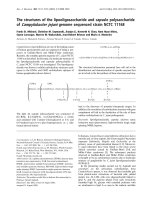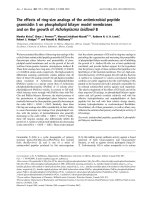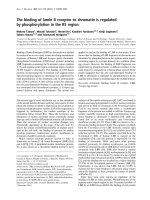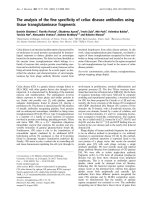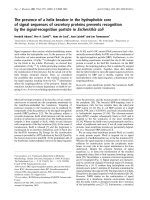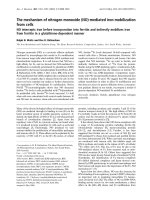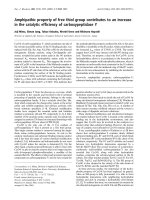Báo cáo y học: "The association of psychological stress and health related quality of life among patients with stroke and hypertension in Gaza Strip" pps
Bạn đang xem bản rút gọn của tài liệu. Xem và tải ngay bản đầy đủ của tài liệu tại đây (253.68 KB, 8 trang )
BioMed Central
Page 1 of 8
(page number not for citation purposes)
Annals of General Psychiatry
Open Access
Primary research
The association of psychological stress and health related quality of
life among patients with stroke and hypertension in Gaza Strip
BT Baune*
1,2
and Y Aljeesh
3
Address:
1
Department of Psychiatry, School of Medicine, James Cook University, Australia,
2
Department of Psychiatry and Psychotherapy,
University of Munster, Germany and
3
Islamic University, Gaza, Palestinian Authority
Email: BT Baune* - ; Y Aljeesh -
* Corresponding author
Abstract
Background: The study was performed to investigate the association of psychological stress and
quality of life (QOL) among patients with the cardiovascular disease (CVD) of hypertension plus
stroke or hypertension only.
Methods: The WHOQOL-BREF questionnaire was applied to 112 hypertensive patients with
hypertension plus stroke and 224 hypertensive patients without stroke. Psychological stress was
assessed with SCL-90. Means scale scores were compared using student-t-test and predictors of
QOL were calculated with covariance analysis.
Results: Patients with stroke had a significant lower QOL than patients without stroke and a
significantly higher level of stress (p < 0.01). In analyses of covariance psychological stress was
significantly correlated to all domains of QOL among non-stroke patients. The same psychological
and sociodemographic factors showed little impact on the stroke patients in these multivariable
analyses. In these models psychological stress had a significant impact on the global domain of QOL
among stroke patients. Income and gender were the only sociodemographic factors being
significantly associated with the physical (education) and social (gender) domains of QOL in stroke
patients.
Conclusion: Psychological stress was strongly correlated with all domains of QOL in patients
without stroke and was only partly associated with QOL among patients with stroke. Future
studies should investigate if psychological stress is a factor suitable for educational and
psychological interventions aiming at stress reduction in CVD patients which might substantially
contribute to better health related quality of life in these patients.
Background
Quality of life (QOL) is a phrase often used in health care
settings at policy and administration levels, in clinical
assessments of therapies, and in clinical management of
individual cases. While QOL is a broad concept that cov-
ers such areas as social, environmental, economic, and
health satisfaction, health-related quality of life (HRQL) is
less wide ranging, including mental and physical health
and their consequences. Health-related quality of life
(HRQL) is considered as one of the key concepts in con-
temporary practice of medicine and delivery of health care
[1-4]. Quality of life assessment is complicated by the fact
Published: 19 May 2006
Annals of General Psychiatry 2006, 5:6 doi:10.1186/1744-859X-5-6
Received: 20 October 2005
Accepted: 19 May 2006
This article is available from: />© 2006 Baune and Aljeesh; licensee BioMed Central Ltd.
This is an Open Access article distributed under the terms of the Creative Commons Attribution License ( />),
which permits unrestricted use, distribution, and reproduction in any medium, provided the original work is properly cited.
Annals of General Psychiatry 2006, 5:6 />Page 2 of 8
(page number not for citation purposes)
that there is no universally accepted definition for QOL.
The researchers of this study have adopted the WHO def-
inition of QOL which identifies QOL as a multidimen-
sional concept. It is defined as "individuals' perceptions of
their position in life in the context of the culture and value
system in which they live and in relation to their goals,
standards, and concerns" [5].
In general, HRQL can be influenced directly and indirectly
by various disease related factors. Chronic diseases, such
as cardiovascular diseases and mental disorders (e.g.
depression) potentially decrease short-term and long-
term HRQL. Direct effects of the disease itself and side
effects of the treatment may influence HRQL in patients
with stroke or hypertension. Hypertension and stroke are
two prevalent medical conditions which may affect qual-
ity of life substantially. Moreover, anti-hypertensive med-
ication may induce fatigue, dizziness, and sexual
dysfunction, which in turn impairs patient's activity of
daily living and quality of life [6-8]. Sexual dysfunction is
not necessarily caused by the hypertensive drug therapy,
but is likely due to other factors such as vascular disease
[9].
Major medical consequences of stroke concern different
physical and psychological aspects such as loss of sense,
palsy, disturbance of body image, depression and change
in patient's role also affecting HRQL. Despite of side
effects of medication (e.g. antidepressant, anti-choliner-
gic, and anti-adrenergic agents) potentially leading to
decreased well-being [10], a meta-analysis of well-selected
and comparable trials has shown the positive impact of
anti-hypertensive medication on patient's quality of life as
a whole despite disturbing side effects [11]. Grimm et al.
showed in a study with patients suffering from mild
hypertension that anti-hypertensive medication improves
quality of life secondary to a reduction of blood pressure
[12].
The assessment of HRQL in this study is based on a holis-
tic and multidimensional approach of HRQL, which
includes several dimensions such as physical, socioeco-
nomic, spiritual and psychological aspects. Stress is
among the psychological factors potentially influencing
QOL [3,4]. Moreover, mental well-being is essential part
of the QOL concept and therefore part of the assessment
of quality of life carried out with e.g. the SF36 instrument
or the WHOQOL questionnaire [5]. In relation to cardio-
vascular diseases, psychological factors such as stress seem
to play an even more important role for patients' HRQOL
suffering from stroke or hypertension than patient charac-
teristics, blood pressure, or drug-related factors [14].
Psychological stress has been targeted in intervention and
rehabilitation programs among patients with hyperten-
sion, because it is believed that stress reduction can
improve hypertension [15]. Certain intervention pro-
grams for stress reduction aimed successfully at a reduc-
tion of blood pressure [15-17].
Despite the positive impact of medication on quality of
life in hypertensive patients suffering from stroke or
hypertension only recent research suggests paying more
attention to psychological factors such as stress account-
ing for quality of life among various cardiovascular disor-
ders, because psychological stress seems to be an
additional factor suitable for interventions aiming at
improved HRQL for these patients [15].
However, little is known about the association of psycho-
logical stress and health related quality of life among
patients with various cardiovascular conditions. To fur-
ther investigate the relationship of psychological stress
and quality of life among these patients, we carried out a
study among patients either with hypertension only or
hypertension plus stroke in Gaza.
Objectives
This study investigates the impact of psychological stress
on health related quality of life (HRQL) among patients
with or without stroke in Gaza Strip.
Study design
A one to two matched case-control study was carried out.
The case group consists of 112 subjects with stroke and
history of hypertension, and the control group consists of
224 subjects with hypertension only. Cases and controls
were matched by age, sex, starting point of therapeutic reg-
imen for both pharmacological and non-pharmacological
treatment, time of hypertension, enrollment location of
hospital related health care clinics and calendar time. For
each case two identical controls were recruited to detect
small differences between the two groups [18] and to
compensate potential loss of controls.
Patients and methods
Cases and controls were recruited from the same geo-
graphical area in Gaza Strip [8,10]. Three main hospitals
in Gaza Strip (Shefa, Nasser, and Khan Younis hospital)
and the geographically and administratively related pri-
mary health care clinics were pinpointed for the selection
of the study population. Each selected primary health care
clinic was associated with one of the three hospitals in
relation to diagnostic and treatment as well as follow-up
procedures. The population under study was aged
between 35 and 69 years. The lower age limit was used,
because hypertension and stroke considerably occur
among people above 34 years of age in Gaza. The upper
limit was chosen because this is the average life expect-
ancy in Gaza Strip. Inclusion and exclusion criteria of the
Annals of General Psychiatry 2006, 5:6 />Page 3 of 8
(page number not for citation purposes)
study will be explicitly given below in the manuscript. The
study was approved by the Ministry of Health in Gaza and
the local ethical committee in Gaza Strip.
Inclusion and exclusion criteria
All available discharge data of patients from the selected
hospitals were screened for cases. Patients who had been
hospitalized for acute stroke and history of hypertension
between 1
st
January and 31
st
December 2001 were defined
as cases (N = 180).
In total 112 (62%) hypertensive patients with stroke were
ultimately selected from the registers. The diagnosis of
stroke was confirmed by a physician and a head CT scan
was performed. Stroke was defined as "a sudden loss of
brain function resulting from disruption of the blood sup-
ply to a part of the brain" [2]. A computed tomography
head scan had been carried out in patients with hyperten-
sion plus stroke. Both groups were selected only, if a his-
tory of other physical diseases (diabetes, myocardial
infarction, atrial fibrillation, pulmonary oedema, asthma)
was excluded. Sixty-eight (38%) out of 180 selected cases
were excluded from the study: 19 (28%) died after first
stroke; eighteen (26%) had a second stroke; seven subjects
(10%) were over 69 years old; 10 (15%) participated in
the pilot study; seven (10%) patients had no computer
tomography head scan; four (6%) refused to participate in
the study; three (4%) patients started their therapeutic
regimen less than one year.
Controls were defined as having hypertension only, with-
out history of stroke prior to interview. Hypertension was
defined when the threshold levels of 140 mm Hg systolic
and 90 mm Hg diastolic were reached at three different
independent measurements within one week, repeated
twice over a 2 months period prior to the diagnosis of
hypertension. Further grading into mild, moderate, severe
hypertension was not made.
Controls may have developed stroke later on after the
study period. The occurrence of potential later develop-
ment of stroke in controls after the interview was studied
for the period of the study by telephone follow-up inter-
view and clinic visits. During the period of the study no
one of the controls developed a stroke.
These patients with a diagnosis of hypertension received
health care follow-up because of anti-hypertensive medi-
cation in eight governmental primary health care clinics.
Controls were selected from the same primary health care
clinics where cases used to receive follow-up appoint-
ments for hypertension on primary health care level
before hospital admission due to the development of
stroke.
Questionnaires
The first part of the questionnaire gives information on
age, gender, marital status, education and socio-economic
status. Quality of life for the period 2 weeks prior to the
interview was assessed with the brief version of the WHO
Quality of life questionnaire [12,13]. Psychological stress
two weeks prior to the interview was assessed using five
psychological items with a 5-level scale ranging from
none to very strong (0–4) adapted from the Symptom
Check List by Derogatis (SCL-90) with regards to (1) nerv-
ousness, (2) paranoia, (3) social phobia, (4) criticism and
(5) loneliness [19]. According to the evaluation of the
SCL-90 items, high scores on each of these psychological
factors express psychological stress. As no cut-off-points
exist for psychological stress measured with the SCL-90,
low stress is indicated by numbers pointing to '0' and high
psychological stress is characterized by numbers pointing
to '20'. The sum score (scale from 0–20) was used as a
continuous variable in the analysis of covariance.
The short version of the WHO Quality of life (WHOQOL-
BREF) assessment gives means of four single domains
(physical, psychological, social, and environmental) and
one overall domain (global value). The range of each
domain of QOL is from 0–100. As no cut-points exist for
good and poor QOL measured by WHOQOL-BREF, poor
quality of life is indicated by numbers pointing to '0' and
high quality is characterized by numbers pointing to
'100'.
A certified translation of the questionnaire from English
into Arabic language including a backward translation
was performed twice independently, and the results were
checked for inconsistencies.
Statistical analysis
Frequency tables were calculated to describe the study
population regarding sex, age, level of stress and quality of
life. The statistical significance of differences between
groups was tested with Mann-Whitney-U-test (tables 2
and 3). Each quality of life domain was correlated with
the continuous variable psychological stress by the use of
Spearman's correlation coefficient (table 3).
Finally, analysis of covariance was carried out for each sin-
gle domain of QOL separate for patients with hyperten-
sion plus stroke and with hypertension only (tables 4 and
5). In these separate covariance models the QOL domains
served as the dependent variables and age (continuous
variable), gender, education (5-level categorical variable),
income (5-level categorical variable) and psychological
stress (continuous variable with a scale ranging from 0–
20) served as covariates. For all statistical procedures SPSS
statistical software, version 12.0 was used.
Annals of General Psychiatry 2006, 5:6 />Page 4 of 8
(page number not for citation purposes)
Results
Study population
In table 1 the distribution of age and gender by diagnosis
is presented. Approximately 70% of the stroke patients
had a cerebral infarction and 30% a hemorrhagic infarc-
tion. The mean age of the study population was 55 years
(SD 6.6). Males (51.8%) were only slightly more frequent
than females in the study population (48.2%). The partic-
ipants were 40–69 years old. Patients from 52 to 63 years
accounted for 57% of the age distribution. One-fourth
(24%) of the patients were over 63 y. Patients aged 45
years old or younger were the smallest group in the study.
Education and income per month
The distribution of educational qualifications and of aver-
age monthly income stratified by disease status is pre-
sented in Table 2. The level of education was significantly
different between patients with hypertension plus stroke
and those with hypertension only (p = 0.001). Patients
with hypertension were generally higher qualified than
those with hypertension plus stroke. Whereas nearly 60%
of patients with hypertension plus stroke presented with-
out a formal qualification (e.g., primary, preparatory, sec-
ondary school, University degree), only a little more than
one third (37.5%) among the patients with hypertension
was formally not qualified. Although we found a trend
that patients with hypertension only had a larger propor-
tion of lower average monthly income compared to their
counterparts, this difference was not statistically signifi-
cant. Furthermore, the results indicate a financially under-
privileged population under study: more than 75% of the
probands had a monthly income of 350 U.S. $ or less
(Table 2).
Psychological stress, clinical, social and demographic
factors
Table 3 presents mean comparisons of the domains of
quality of life stratified by diagnosis, gender, education
and income. Mean comparisons were made with student-
t test. The results show statistically significant poorer qual-
ity of life across all domains among patients with the diag-
nosis of hypertension plus stroke, female gender, and
among those with low education and low income com-
pared to their counterparts. Psychological stress was statis-
tically significant inversely correlated with the physical,
psychological, social, environmental and global domains
of QOL.
Age had no significant impact on any of the domains of
QOL (data not shown).
Association of psychological stress and QOL
Tables 4 and 5 present results of separate analyses of cov-
ariance estimating the impact of psychological stress and
other factors on domains of QOL separate for patients
with hypertension only and those with hypertension plus
stroke.
Psychological stress was statistically significant correlated
with all domains of QOL in patients with hypertension
(Table 4). While gender was significantly correlated with
the psychological, social, environmental and global
domain of QOL among patients with hypertension, no
such significant association was found for age. Education
was significantly related to all single domains of QOL
(except the global value). Income showed a significant
association with the physical, psychological, environmen-
tal and global domain, but not with the social domain
among patients with hypertension only (Table 4).
A different picture resulted from the analysis of covariance
for patients with hypertension plus stroke (Table 5). Psy-
chological stress was significantly correlated with the glo-
bal domain only and income was significantly associated
with the physical domain of QOL. Gender was signifi-
cantly associated with quality of life in the social domain.
Table 1: Gender and age among stroke and non-stroke patients
Stroke
(N = 112)
Non-stroke
(N = 224)
NN
Gender
Female 54 108
Male 58 116
Age Male % Female % Male % Female %
40–45 3 33.3 66.7 6 33.3 66.7
46–51 18 55.6 44.4 36 55.6 44.4
52–57 32 53.1 46.9 64 53.1 46.9
58–63 32 56.3 43.7 64 56.3 43.7
64–69 27 44.4 55.6 54 44.4 55.6
Annals of General Psychiatry 2006, 5:6 />Page 5 of 8
(page number not for citation purposes)
The variables education and age were not significantly
correlated to any of the domains of QOL among patients
with hypertension plus stroke (Table 5).
Discussion
In this study we investigated the association of psycholog-
ical stress and quality of life among patients suffering
from the chronic and potentially disabling cardiovascular
conditions of hypertension or hypertension plus stroke.
Table 2: Education and average income in $ per month among stroke and non-stroke patients
Stroke (N = 112) Non-stroke (N = 224) Mann-Whitney-U-test
n, (%) n, (%) p-value
Level of education
No education 67 (59.8) 84 (37.5)
Primary school 11 (9.8) 29 (12.9)
Preparatory school 8 (7.1) 44 (19.6)
Secondary school 15 (13.4) 41 (18.3) 0.001
University degree 10 (8.9) 25 (11.2)
Other 1 (0.9) 1 (0.4)
Total 112 (100) 224 (100)
Average income per month in
U.S. $
Less than 200 U.S. $ 48 (42.9) 101 (45.1)
200–350 U.S. $ 29 (25.9) 76 (33.9)
360–550 U.S. $ 29 (25.9) 39 (17.4)
560–750 U.S. $ 6 (5.4) 8 (3.6) 0.236
More than 750 U.S. $ - -
Total 112 (100) 224 (100)
Table 3: Clinical and sociodemographic factors and psychological stress by domains of quality of life
Domains of quality of life
d
Characteristics Physical Mean (SD) Psychological Mean
(SD)
Social Mean (SD) Environmental
Mean (SD)
Global Mean (SD)
Diagnosis
Stroke 41.26 (15.49)*** 40.47 (15.31)*** 51.04 (17.37)*** 46.04 (17.41)*** 45.2 (23.14)***
Non-stroke 67.45 (15.69) 64.76 (17.19) 71.25 (15.03) 61.71 (15.26) 65.46 (18.58)
Gender
Male 61.99 (19.38)*** 61.09 (19.97)*** 68.15 (17.98)*** 60.35 (17.86)*** 62.36 (21.51)***
Female 55.25 (19.95) 51.9 (19.28) 60.59 (18.25) 52.33 (16.41) 54.78 (22.60)
Education
a
Low 54.84 (19.31)*** 53.24 (18.50)*** 61.87 (17.66)*** 52.59 (16.18)*** 55.45 (21.83)***
High 68.93 (17.83) 65.59 (21.56) 71.42 (18.85) 66.63 (17.25) 67.20 (21.49)
Income
b
Low 54.46 (18.45)*** 51.15 (19.01)*** 61.41 (17.61)*** 51.20 (16.43)*** 54.78 (22.02)***
High 62.15 (20.42) 61.05 (19.98) 66.98 (18.82) 60.69 (17.43) 61.83 (22.14)
Psychological stress
c
-0.339 *** -0.247 *** -0.231 *** -0.245 *** -0.284 ***
p-value of Mann-Whitney-U-test: * not significant; ** p < 0.05; *** p < 0.01;
a
Level of education (highest degree) was classified into two groups: low level = 'no education' or 'primary school' or 'preparatory school'. high level
= 'secondary school' or 'University degree';
b
Level of income per month: low level = income < 200 U.S. $ per month; high level = income of >200 U.S. $ per month;
c
Spearman's correlation coefficient of the continuous variables stress and domains of QOL; p-value of correlation coefficient: * not significant; ** p
< 0.05;
d
range of scale of domains of QOL: 0 = poorest QOL; 100 = best QOL;
Annals of General Psychiatry 2006, 5:6 />Page 6 of 8
(page number not for citation purposes)
In general, patients with hypertension plus stroke rated
statistically significant lower quality of life than their
purely hypertensive counterparts. In the analyses of covar-
iance we found that psychological stress was significantly
related to all domains of QOL among patients with hyper-
tension. Contrary, psychological stress had no major
effect on domains of QOL among hypertension plus
stroke patients in these multivariable models.
Several other studies confirm the finding that patients
with hypertension plus stroke have lower QOL than those
with hypertension only due to the disabling effects of
stroke [20-22]. In more general terms, Kempen et al.
showed that health related quality of life is substantially
affected by chronic medical morbidity, such as stroke and
hypertension [22]. Especially the disabling effects of
stroke may have an effect on reduced QOL even 1 year
after stroke as reported by Wyller et al. [24]. However,
findings on QOL and hypertension may be biased by a
underreporting. Studies by MacDonald et al. and Stein et
al. showed that hypertensive patients tend to underesti-
mate the impact of hypertension on quality of life [24,25].
This tendency of underestimation in hypertensive patients
may also have occurred in our study and my have influ-
enced the marked differences of perceived quality of life
between patients with hypertension plus stroke and
patients with hypertension only in our sample.
Another main finding of this study is that psychological
stress was related to all domains of quality of life among
hypertensive patients. This result confirms findings in a
study from Ames et al. among hypertensive patients stat-
ing that quality of life is associated with psychological
stress, even when accounted for age and number of
chronic illnesses [15]. As stress is part of lifestyle it has
been shown by McDonald that high self perceived stress
was related to uncontrolled hypertension [24]. These
results are important in light of potential interventions
aiming at stress reduction in hypertensive CVD patients.
Carlson et al. demonstrated that stress reduction
enhanced quality of life in outpatients with breast cancer
[26], but studies lack for the impact of such interventions
on QOL in CVD patients. Thus, stress-reducing techniques
might be particularly helpful in the setting for hyperten-
sive and stroke patients aiming at a reduction of hyperten-
sion, at lowering the risk for (re-)stroke due to
hypertension and subsequently to an improved quality of
live [15-17].
The results from our study on the relationship between
quality of life and socio-demographic characteristics
Table 4: Analysis of covariance for the impact of psychological stress, demographic and social factors on domains of quality of life
among patients with hypertension
Domains
of QOL
Physical Psychological Social Environmental Global
Factors F-value (df) p F-value (df) p F-value (df) p F-value (df) p F-value (df) p
Stress 9.3 (1) 0.00 5.2 (1) 0.02 7.9 (1) 0.005 5.4 (1) 0.02 4.6 (1) 0.03
Age 0.09 (1) 0.77 0.04 (1) 0.83 0.5 (1) 0.48 0.24 (1) 0.63 0.1 (1) 0.75
Gender 2.6 (1) 0.11 16.1 (1) 0.00 9.4 (1) 0.002 5.02 (1) 0.03 4.02 (1) 0.04
Education 4.5 (5) 0.00 2.9 (5) 0.02 2.9 (5) 0.01 3.5 (5) 0.00 0.93 (5) 0.47
Income 5.7 (3) 0.00 5.1 (3) 0.00 1.7 (3) 0.16 9.1 (3) 0.00 3.5 (3) 0.02
F-value = value of covariance analysis; df = degree of freedom; p = level of significance
Table 5: Analysis of covariance for the impact of psychological stress, demographic and social factors on domains of quality of life
among patients with stroke
Domains
of QOL
Physical Psychological Social domain Environmental Global
Factors F-value (df) p F-value (df) p F-value (df) p F-value (df) p F-value (df) p
Stress 2.9 (1) 0.09 0.00 (1) 0.99 0.08 (1) 0.88 1.8 (1) 0.21 5.3 (1) 0.02
Age 1.7 (1) 0.21 2.6 (1) 0.10 0.07 (1) 0.83 0.7 (1) 0.42 1.6 (1) 0.12
Gender 2.8 (1) 0.83 1.5 (1) 0.22 3.9 (1) 0.05 2.5 (1) 0.12 2.2 (1) 0.14
Education 1.5 (5) 0.21 1.1 (5) 0.37 0.4 (5) 0.85 2.1 (5) 0.07 0.55 (5) 0.74
Income 2.8 (3) 0.04 2.0 (3) 0.12 1.6 (3) 0.22 1.2 (3) 0.34 1.3 (3) 0.26
F-value = value of covariance analysis; df = degree of freedom; p = level of significance
Annals of General Psychiatry 2006, 5:6 />Page 7 of 8
(page number not for citation purposes)
among patients with hypertension plus stroke are partly
contrary to findings from Wyller et al. who reported
female gender and a good social network as correlates of
subjective well-being one year after stroke [26]. In our
study we found only particular evidence for this correla-
tion: gender had an impact on the social domain of QOL
and income on the physical domain of QOL among
patients with hypertension plus stroke. Other sociodemo-
graphic characteristics such as age and education showed
no significant impact on any domain of QOL among
hypertension plus stroke patients.
While education had no significant impact on any of the
QOL domains among patients with hypertension plus
stroke, we found a statistically significant correlation
between education and several domains of QOL among
patients with hypertension. These results become mean-
ingful in light of Dressler's study, who reported, that lower
education was associated with high blood pressure and
high mortality from cardiovascular disease [28]. Accord-
ing to these findings it can be hypothesized, that educa-
tional interventions on healthy life styles may play an
essential part in the prevention of high blood pressure
and fatal cardiovascular events.
Special characteristics of the Palestinian political and eco-
nomic situation may have contributed to these findings
indicating the significant relation of QOL and income and
education in Gaza Strip. Unemployment and poverty are
the strongest challenges hampering human development
in Gaza Strip [29].
The demonstrated gab in quality of life between males
and females in our study may also be due to the Palestin-
ian male-dominant culture, but also due to additional
gynecological problems, and physiological differences
(menstruation, child birth, and menopause), which affect
women's health both physically and mentally. The Cent-
ers for Disease Control and Prevention supports this find-
ing with their statement that decreased health related
quality of life is a particularly important issue among
women [30]. In addition, Barajas et al. found that female
gender and low level of education were significantly asso-
ciated with worse scores of quality of life in primary care
patients with obesity [31].
Limitations of the study
The duration of treatment of hypertension or stroke was at
least 1 year at the time patients were included into the
study. No more medical details on the course of the dis-
ease in the previous year, on the type of brain lesion of
stroke or the severity of the CVD condition potentially
influencing QOL were obtained. However, for the pur-
pose of this study which was to measure the association of
psychological stress and QOL, it was important to have
relatively stable medical conditions of hypertension and
stroke. It was assumed that the medical condition of
hypertension or hypertension plus stroke with the dura-
tion of at least one year had been chronic and relatively
stable when patients were interviewed. However, we were
not able to take the drugs patients were taking into
account since pharmacotherapy used in hypertension or
in stroke may impair quality of life.
The cross-sectional design of the study does not allow for
any stable prospective conclusions on the relationship of
CVD conditions and QOL, although QOL was measured
after the onset of the disease.
The presented data showed that the selected variables
(age, gender, income, education and psychological stress)
largely explained the variance of the single domains of the
QOL in hypertensive but not in hypertensive plus stroke
patients. Future research could focus on further explana-
tory variables for quality of life in patients with hyperten-
sion plus stroke or hypertension only, such as cognitive
and psychological (e.g. orientation, memory, attention,
concentration, language) factors with impact on general
functioning, general well-being and QOL. Previous
research suggests addressing neuro-psychological features
in QOL research might be beneficial as these factors are
suitable for the rehabilitation of CVD patients [32].
Conclusion
It can be concluded that QOL in patients with hyperten-
sion plus stroke is likely to be more influenced by the dis-
abling effect of stroke itself, and it appears to be less
attributable to psychological stress and sociodemographic
factors than in patients with hypertension. Future research
is needed to confirm these results.
As psychological stress is a modifiable risk factor, inter-
ventions aiming at stress reduction in hypertensive
patients might substantially contribute to a better quality
of life and to the prevention of stroke in hypertensive
patients.
Declaration of competing interests
The author(s) declare that they have no competing inter-
ests.
Authors' contributions
BB conceived the study, designed and developed the ques-
tionnaire, performed statistical analysis and drafted the
manuscript. YA conceived the study and participated in
the design and development of the questionnaire, co-
ordinated and carried out the data collection in Gaza and
helped to draft the manuscript. All authors read and
approved the final manuscript.
Publish with BioMed Central and every
scientist can read your work free of charge
"BioMed Central will be the most significant development for
disseminating the results of biomedical research in our lifetime."
Sir Paul Nurse, Cancer Research UK
Your research papers will be:
available free of charge to the entire biomedical community
peer reviewed and published immediately upon acceptance
cited in PubMed and archived on PubMed Central
yours — you keep the copyright
Submit your manuscript here:
/>BioMedcentral
Annals of General Psychiatry 2006, 5:6 />Page 8 of 8
(page number not for citation purposes)
Acknowledgements
We are grateful to our patients, and to medical staff in hospitals and pri-
mary health care clinics in Gaza for their help to recruit them.
References
1. Lerner D, Levine S: Health related quality of life: origins, gaps,
and directions. Advances in Medical Sociology 1994, 5:43-65.
2. Nordenfelt L: Concepts and measurement of quality of life in
health care. Dordrecht. Netherlands 1994:201-227.
3. Avis N, Smith K: Conceptual and methodological issues in
selecting and developing quality of life measures. Advances in
Medical Sociology 1994, 5:255-280.
4. Vallerand A, Breckenridge D, Hodgson N: Theories and concep-
tual models to guide quality of life related research. Jones and
Bartlett, London, UK; 1998:37-50.
5. The WHOQOL Group: Development of the World Health
Organization WHOQOL-Bref quality of life assessment. Psy-
chological Medicine 1998, 28:551-559.
6. Cella D, Wiklund I, Shumaker S, Aaronson N: Integrating health-
related quality of life into cross-national clinical trials. Inter-
national Assessment of Health-Related Quality of Life. Com-
munications of Oxford Ltd., UK; 1995:75-82.
7. Duncan L, Bateman DN: Sexual function in women. Do anti-
hypertensive drugs have an impact? Regional drug and therapeutic
center 1993, 8(3):225-234.
8. Weiss RJ: Effects of anti-hypertensive agents on sexual func-
tion. American Family Physician 1991, 44(6):2075-2082.
9. Grimm RH, Grimm RH Jr, Grandits GA, Prineas RJ, McDonald RH,
Lewis CE, Flack JM, Yunis C, Svendsen K, Liebson PR, Elmer PJ: Long-
term effect on sexual function of five anti-hypertensive drugs
and nutritional hygienic treatment in hypertensive men, and
women. Hypertension 1997, 29:8-14.
10. Ozer M, Materson R, Caplan L: Management of persons with
stroke. Mosby, USA; 1994:41-53.
11. Leonetti G, Comerio G, Cuspidi C: Evaluating quality of life in
hypertensive patients. J Cardiovasc Pharmacol 1994, 23(suppl
5):54-58.
12. Grimm RH, Grimm RH Jr, Grandits GA, Cutler JA, Stewart AL,
McDonald RH, Svendsen K, Prineas RJ, Liebson PR: Relationships of
quality of life measures to long term lifestyle and drug treat-
ment in the treatment of mild hypertension study. Arch Intern
Med 1997, 157:638-648.
13. WHO: WHOQOL-BREF: Introduction, administration, scor-
ing, and generic version of the assessment. Geneva 1996.
14. Erickson SR, Williams BC, Gruppen LD: Relationship between
symptoms and health-related quality of life in patients
treated for hypertension. Pharmacotherapy 2004, 24(3):344-50.
15. McCraty R, Atkinson M, Tomasino D: Impact of a workplace
stress reduction program on blood pressure and emotional
health in hypertensive employees. Altern Complement Med 2003,
9(3):355-69.
16. Ames SC, Jones GN, Howe JT, Brantley PJ: A prospective study of
the impact of stress on quality of life: an investigation of low-
income individuals with hypertension. Ann Behav Med 2001,
23(2):112-9.
17. Fallo F, Barzon L, Rabbia F, Navarrini C, Conterno A, Veglio F, Caz-
zaro M, Fava GA, Sonimo N: Circadian blood pressure patterns
and life stress. Psychother Psychosom 2002, 71(6):350-6.
18. Schlesselman J, Stolley P: Case-Control Studies: design, conduct,
analysis. Oxford University, USA; 1982.
19. Derogatis LR: SCL-90-R: administration, scoring, procedures.
Manual I for the revised version. John Hopkins University School
of Medicine; 1977.
20. Angeleri F, Angelerie VA, Foschi N, Giaquinto S, Nolfe G: The influ-
ence of depression, social activity, and family stress on func-
tional outcome after stroke. Stroke 1993, 24(10):1478-83.
21. de Haan RJ, Limburg M, Van der Meulen JH, Jacobs HM, Aaronson
NK: Quality of life after stroke. Impact of stroke type and
lesion location. Stroke 1995, 26(3):402-8.
22. Jaracz K, Opala T: Quality of life of women after ischemic
stroke. Ginekol Pol 2003, 74(1):17-23.
23. Wyller TB, Sveen U, Sodring KM, Petterson AM, Bautz-Holter E:
Subjective well-being one year after stroke. Clin Rehabil 1997,
11(2):139-45.
24. MacDonald MB, Sawatzky JE, Wilson TW, Laing GP: Lifestyle pro-
files of hypertensives. Can J Cardiocasc Nurs 1991, 2(2):3-8.
25. Stein JD, Brown GC, Brown MM, Sharma S, Hollands H, Stein HD:
The Quality of life of patients with hypertension. J Clin Hyper-
tens 2002, 4(3):181-188.
26. Carlson Le, Speca M: Mindfulness based stress reduction in
quality of life, mood, symptoms of stress, cortisol, dehyroe-
piandrosterone sulfate (DHEAS) and melatonin in breast
and cancer outpatients. Psychoneuroendocrinology 2004,
29(4):448-474.
27. Wyller TB, Holmen J, Laake P, Laake K: Correlates of subjective
well-being in stroke patients. Stroke 1998, 29(2):363-7.
28. Dressler WW: Education, lifestyle and arterial blood pressure.
Psychosom Res 1990, 34(5):515-23.
29. Center for Disease Control and Prevention: Chronic disease pre-
vention. CDNR 2003, 16(1):2-6.
30. Barajas MA, Robledo E, et al.: Quality of life in relation to health
and obesity in a primary center. ESP Salud Publica 1998,
72(3):221-231.
31. Richard H: Perceptions about quality of life in San Antonio.
UTSA Metropolitan Research and Policy Institute. Hispanic
Journal 2002, 27(12):20-25.
32. Hochstenbach JB, Anderson PG, van Limbeck J, Mulder TT: Is there
a relation between neurophysiologic variables and quality of
life after stroke? Arch Phys Med Rehabil 2001, 82(19):1360-6.


